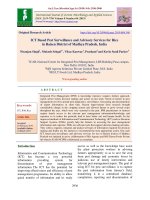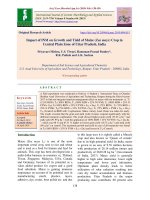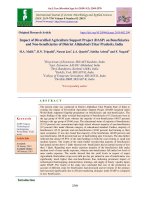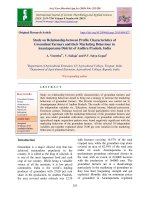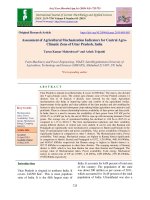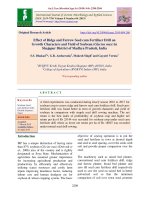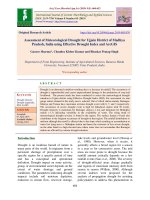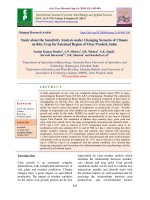Evaluation of agricultural mechanization indicators for Eastern region of Uttar Pradesh, India
Bạn đang xem bản rút gọn của tài liệu. Xem và tải ngay bản đầy đủ của tài liệu tại đây (247.03 KB, 9 trang )
Int.J.Curr.Microbiol.App.Sci (2019) 8(9): 141-149
International Journal of Current Microbiology and Applied Sciences
ISSN: 2319-7706 Volume 8 Number 09 (2019)
Journal homepage:
Original Research Article
/>
Evaluation of Agricultural Mechanization Indicators for
Eastern Region of Uttar Pradesh, India
Tarun Kumar Maheshwari* and Ashok Tripathi
Farm Machinery and Power Engineering, VSAET, Sam Higginbottom University of
Agriculture, Technology and Sciences (SHUATS), Allahabad-211 007, UP, India
*Corresponding author:
ABSTRACT
Keywords
Mechanization
index, Farm power,
Degree of
mechanization,
Cropping intensity,
Human energy,
Mechanical energy,
Total energy
Article Info
Accepted:
04 August 2019
Available Online:
10 September 2019
Uttar Pradesh is the most populous state in India and every fourth farmer in the country
comes from here. Hence, one cannot expect the farmers‟ welfare in India without
considering the farmers of Uttar Pradesh. About 17 per cent of total food grain production
of the country comes from Uttar Pradesh. Agriculture in Uttar Pradesh is less lucrative as it
is characterized by low crop yield, mainly fine cereals (rice and wheat) and high interregional variation. The state is also divided into 9 agro-climatic zones. The eastern region
of Uttar Pradesh consists of three agro-climatic zones. From each agro climatic zone one
district was selected for mechanization study in agriculture which helps in improving
safety and comfort of the agricultural worker. In India, there is a need to increase the
availability of farm power from 2.02 kW per ha (2016-17) to 4.0 kW per ha by the end of
2030 to cope up with increasing demand of food grains. The farm mechanization
indicators and their variability among all agro-climatic zones of eastern region were
studied. The mechanization index, power availability, total energy, mechanical energy,
human energy are highest in eastern plain zone in comparison to north eastern plain zone
and Vindhyan zone i.e. 0.954, 2.93 kW/ha, 883 kWh/ha, 748.45 kWh/ha and 139.21
kW/ha respectively but the farmers income is lowest in eastern plain zone in compare to
other two zones. The cropping intensity of eastern plain zone district is 196% which is
more than north eastern plain zone as well as Vindhyan zone. The average value of
mechanization index, power availability, total energy, mechanical energy, cropping
intensity, human energy, annual farmer income, annual input cost, irrigation intensity in
eastern region of Uttar Pradesh in the year 2018-19 were 0.951, 2.61 kW/ha, 735.94
kWh/ha, 655.49 kWh/ha, 160.42 %, 81.98 kWh/ha, Rs.177125, Rs.49586 and 160.42 %
respectively.
Introduction
Uttar Pradesh is the most populous state in
India and every fourth farmer in the country
comes from here. Hence, one cannot expect
the farmers‟ welfare in India without
considering the farmers of Uttar Pradesh.
Apart from this, Uttar Pradesh is the largest
producer of agricultural products in India.
About 17 per cent of total food grain
141
Int.J.Curr.Microbiol.App.Sci (2019) 8(9): 141-149
production of the country comes from Uttar
Pradesh. Despite these achievements for the
state, the situation of its farmers is not very
good. Agriculture in Uttar Pradesh is less
lucrative as it is characterized by low crop
yield, mainly fine cereals (rice and wheat) and
high inter-regional variation. Agriculture is
main source of livelihood to majority of the
population of Uttar Pradesh More than 70
percent of population Uttar Pradesh directly or
indirectly depend on agriculture and allied
sectors. The percentage of net area sown to
reporting area in Uttar Pradesh has been
decreasing continuously due to fast expansion
of industrialization and urbanization in the
state. Eastern region of Uttar Pradesh is flood
prone and poverty is acute in this region,
therefore household food security is primary
concern of the farm households in this region.
To meet the household food security as high
as 91 per cent of all agricultural land was
allocated to food grain crops. In this region
wheat and rice shared 75 per cent of gross
cropped area. The productivity went up
significantly during last two decades mainly
due to rise in yields. The chickpea and pigeon
pea were the main pulses in this region. The
highest density of population is also found in
this region. On account of highest density of
population, the per capita availability of land
is very low in comparison to other region of
the state. The mechanizing in crop farming is
also much prevalent in Uttar Pradesh. The use
of tractors, seed drills, rotavators, threshers,
cultivators etc are very much common for
agriculture and allied activities in Uttar
Pradesh. Most of agricultural operations and
activities are mostly performed by tractors in
Uttar Pradesh. The diesel and electric tubewells are being largely used across the state.
The zero till multi crop Planter and zero tillseed drill were very less in number in Uttar
Pradesh. According to agro-climatic zone, the
eastern region of Uttar Pradesh consists of 3parts i.e. north eastern plain zone, eastern
plain zone and Vindhyan zone.
The Eastern Plain Zone includes Azamgarh,
Mau,
Balia,
Faizabad,
Ghazipur,
Jaunpur, Chandauli, Barabanki, Sultanpur,
Amethi, Sant Ravidas Nagar and Varanasi
districts. The rainfall is adequate with a
normal of 103 cm. The average food grain
production is 23.43 q/ha. The soil of this zone
is alluvial, sodic and diara soil. The cultivated
area is about 32.05 lakh ha. The climate is dry
sub-humid to moist sub-humid. Over 70% of
the land is cultivated and more than 80% of
the cultivated area is irrigated.
The North Eastern Plains Zone includes the
districts of Baharaich, Gonda, Balrampur,
Basti, Gorakhpur, Sidharth Nagar, Shravasti,
Sant Kabir Nagar, Lakhimpur Kheri,
Maharajgunj, Kushinagar and Deoria. The
productivity of food grain is 25.17 q/ha. The
type of soil of this zone is alluvial and
calcareous soil. The rainfall is quite high at
about 121 cm, the climate is moist sub-humid
to dry sub-humid. 73% of the land area is
cultivated and about half of the cultivated land
is irrigated. Tube wells are the major source of
irrigation.
This Vindhyan Zone includes Mirzapur,
Santravidas nagar, Sonbhadra districts of Uttar
Pradesh. The average rainfall is adequate at
about 114 cm. The productivity of food grain
of this zone is 17.62 q/ha. The zone has black
heavy, red granular and alluvial soil. The
climate is similar to the other parts of the
eastern plains of Uttar Pradesh. The irrigated
area is 52.85 percent. The type of soil is black
heavy, red granular and alluvial soil. The
cultivated area is 11.34 lakh ha. However, the
region has a very high forest cover of about
40% of the land. Less than a third of this land
is cultivated and only a third of this is
irrigated.
In modern era, agricultural mechanization
draws a major controversy that it is considered
as the application of mechanical power
142
Int.J.Curr.Microbiol.App.Sci (2019) 8(9): 141-149
technology, particularly tractors. However,
three main levels of mechanization
technologies need consideration: human
power, animal power and mechanical power
technologies, with varying degrees of
sophistication within each level (Rijk, 1989),
on the basis of capacity to do work, costs, and
precision and effectiveness (Morris, 1985).
Agricultural mechanization technology further
varies from location to location and crop to
crop. Thus the quality of inputs of
mechanization, and consequently land and
labor productivity may differ considerably
(Gifford and Rijk, 1980). So, mechanization
planning requires the quantification of level of
mechanization for each crop production.
Several authors developed different methods
to quantify the level of mechanization based
on power or energy availability, and its impact
in agricultural and labor productivity.
of machinery a given farmer uses for farm
work compared with the average in the region.
The second term in Equation (1) includes a
ratio between the land area cultivated with
soybean crop and the total land ownership.
This term was introduced because it reflects
the importance of land demand for cultivation.
The LOM index is based on the premise that a
mechanized farmer is the one that finds a way
to utilize amounts of mechanical energy that
are higher than the typical values using locally
available technology.
Zangeneh
et
al.,
(2010)
defined
Mechanization Index (MI) and Level of
Mechanization (LOM), to characterize
farming system of potato in the Hamadan
province of Iran. These indicators are defined
mathematically as equations (1) and (2)
respectively. The MI elaborated here is an
expression of the deviation of the actual
amount of motorized farm work from the
normal values at the regional level.
Field capacity was multiplied by rated power
so the quantification of energy expenditure
was made in work units (kWh). The regional
normal will be obtained after compiling a full
dataset of all respondents and then it would be
defined the mode for the number of passes for
each operation as well as the mode in tractor
size and field capacity.
Where, LOM = level of mechanization, Pi=
power of tractors, η = correction factor for
utilized power (0.75).
The level of mechanization is calculated by
the following formula (Almasi et al., 2000).
Mechanization
Where,
MI = Mechanization Index for the production
unit `a`, Me(i) = Overall input energy due to
machinery in the production unit `a`, Mav =
Regional-average energy due to machinery, Li
=Land area cultivated in the production unit
`a`, TLi = Total farm land ownership of
production unit `a`, n = Number of farms.
The MI index, proposed by Andrade and
Jenkins (2003) is an indication of the amount
level
The Total power of existing tractors (hp) =
Average nominal power of one tractor x
Number of working tractors.
Total real power of tractors= Total power of
existing tractors x Conversion coefficient
(0.75).
Animal energy (hp-h) = Total existing animal
power x Annual functional hours.
143
Int.J.Curr.Microbiol.App.Sci (2019) 8(9): 141-149
Annual functional hours = Number of
functional days x Mean functional hours
during a day.
Total existing animal power (hp) = Produced
power of animal x Number of animals.
Human energy (hp-h) =Total exiting human
power x annual functional hours.
Annul functional hours= Number of functional
days x Mean functional hours during a day.
Total existing human power (hp) = Produced
power of human x Number of humans.
Materials and Methods
After selection of variables, a questionnaire
was prepared to collect primary data from
each agro-climatic zone of eastern region. The
selected district from each agro-climatic zone
of eastern region was, Varanasi from eastern
plain zone, Lakhinpur kheri from north eastern
plain zone and Mirjapur from Vindhyan zone
eastern region of Uttar Pradesh. A stratified
multistage sampling design was applied
considering district and village as strata. The
villages were selected from three mentioned
districts from eastern agro-climatic zones in
eastern region of Uttar Pradesh using random
sampling and 3 districts out of 27 districts of
eastern region were taken for the study. Then
from each district, 6 villages and then from
each villages, 10 farmers were selected using
random sampling. Primary data were collected
from 180 farmers from 18 villages of 3
districts i.e. 60 farmers from each district. As
mechanization is a multi-dimensional concept,
thus the following indices were evaluated to
study the mechanization status in target
region. To study the mechanization status of
three districts of eastern region of Uttar
Pradesh The many variables were selected
based on requirements to estimate degree of
mechanization, level of mechanization (power
availability), mechanization index, cropping
intensity, irrigation intensity, input cost and
farmers Income. The following variables were
selected:
Degree of mechanization (MD)
It is one of the quantitative measure of
mechanization, by which the degree of
mechanization of different operations in a
cropping system like land preparation, sowing,
weeding, irrigation, spraying, harvesting,
threshing, transportation of agri-cultural
produce and etc. can be assessed. It is the ratio
of mechanization area accomplished to the
area to be mechanized (Almasi et al., 2000).
The degree of mechanization of particular
implements used in a particular agricultural
operation can be given as:
Degree of Mechanization =Mechanized
area/Area to be mechanized. …(4)
In other words, the degree of mechanization
can be used to evaluate the extent of different
agricultural operations performed using
machinery or improved implements to the
operations performed by humans, animals or
traditional implement ie Area under bullocks,
cultivator, power tiller, disc plough, M B
plough, deshi hal (local plough), seed cum
fertilizer drill, diesel engine, electric pump,
sprinkler,
dripper,
sprayer
(manually
operated), sprayer (tractor operated), manual
harvesting, thresher and combine harvester.
Level of mechanization (power availability)
Farm power is an essential input in
agricultural production system to operate
different types of equipment for timely field
completion of agricultural works to increase
productivity and maintain sustainability of
farm. The mobile power is used for different
field jobs like land preparation, sowing,
weeding, spraying, and harvesting etc.,
144
Int.J.Curr.Microbiol.App.Sci (2019) 8(9): 141-149
whereas stationary power is used for lifting
water, operating irrigation equipment,
threshing, cleaning and grading of agricultural
produce. The main sources of mobile power
are human, draught animal, tractors, power
tiller and self-propelled machines (combines,
dozers, reapers, sprayers and etc.) where as the
source of stationary power is oil engines and
electric motors. In this study, power
availability was also evaluated for eastern
region of Uttar Pradesh. The main sources of
mobile power were human, draught animal,
tractors and combines whereas the sources of
stationary power were oil engines, electric
motors and threshers in the eastern region. The
power availability was evaluated using
formula given by Equation 5.
Power availability (hp/ha) = Total Power/Net
Cultivated Area...(5)
Where, Total power = Total mobile power +
Total stationary power
Net Cultivated Area = Net Cultivated Area of
Target Region Villages wise number of
tractor,
combine
harvester,
bullocks,
agricultural workers, power tiller, diesel
engines and electric pump.
Results and Discussion
The graphical representation of variation of
mechanization index, power availability, total
energy, cropping intensity, irrigation intensity,
human energy, degree of mechanization,
annual input cost, mechanical energy and
annual farmers income for eastern region of
three agro climatic zones i.e. eastern plain
zone, north eastern plain zone and Vindhyan
zone are shown in figure from 1 to 10. The
farm mechanization indicators and their
variability among different agro-climatic
zones of eastern region were studied. It can be
seen that eastern plain zone is more
mechanized in terms of mechanization index
and farm power availability and Vindhyan
zone is least mechanized (Table 1).
From the graphs, it is also clear that north
eastern plain zone is more mechanized than
Vindhyan zone as per mechanization index
and farm power point of view. The farm
power value in eastern plain zone is 13.66 %
more than north eastern plain zone. Similarly
mechanization indicators and other parameters
of eastern plain zone are also high in compare
to other two zones in eastern region as shown
in graphs. The degree of mechanization of
different farm implements in different unit
operation is also shown in table 2. It is also
found that the degree of mechanization of
harvesting
worker
is
highest
than
mechanization with cultivator. Still harvesting
with harvesting worker is very popular among
the farmer and farm implement cultivator is
also very versatile farm implement for the
farmer.
Table.1 Mechanization status parameters of Eastern region in Uttar Pradesh
Sl. No.
1.
2.
3.
4.
5.
6.
7.
8.
9.
Mechanization status parameters
Mechanization Index
Farm Power (kW/ha)
Cropping Intensity (%)
Irrigation Intensity (%)
Annual Farmers Income (Rs)
Annual Input cost (Rs)
Human Energy (kWh/ha)
Mechanical Energy (kWh/ha)
Total Energy (kWh/ha)
145
Average Values
0.951
2.61
160.42
160.42
177125
49586
81.98
655.49
735.94
Int.J.Curr.Microbiol.App.Sci (2019) 8(9): 141-149
Table.2 Degree of mechanization of different farm implements of Eastern region of UP
Degree of mechanization
Cultivator
Power tiller
Disc plow
M B plow
Desi hal
Disc harrow
Leveller
Puddler
Bundmaker
Rotavator
Seed cum ferti drill
Diesel engine
Electric Pump
Sprinkler
Dripper
Spray manual
Spray tractor
Harvesting worker
Harvesting harvester
Thresher
Figures
146
Average values
0.558
0.000
0.139
0.005
0.000
0.168
0.049
0.287
0.006
0.000
0.013
0.238
0.250
0.002
0.000
0.379
0.001
0.996
0.016
0.289
Int.J.Curr.Microbiol.App.Sci (2019) 8(9): 141-149
147
Int.J.Curr.Microbiol.App.Sci (2019) 8(9): 141-149
In conclusion, the Mechanization index,
Power availability, Total energy, Mechanical
energy, human energy are highest in eastern
plain zone in comparison to north eastern
plain zone and Vindhyan zone i.e. 0.954, 2.93
kW/ha, 883 kWh/ha, 748.45 kWh/ha and
139.21 kW/ha respectively but the farmers
income is lowest in eastern plain zone in
compare to other two zones. The cropping
intensity of eastern plain zone district is 196%
which is more than north eastern plain zone as
well as Vindhyan zone. The average value of
mechanization index, power availability, total
energy,
mechanical
energy,
cropping
intensity, human energy, annual farmer
income, annual input cost, irrigation intensity
in eastern region of Uttar Pradesh are 0.951,
2.61 kW/ha, 735.94 kWh/ha, 655.49 kWh/ha,
160.42%, 81.98 kWh/ha, Rs.177125, Rs.
49586 and 160.42 % respectively.
16 (Phase I) Provisional Results,
Department
of
Agriculture,
Cooperation and Farmers Welfare,
Government of India (GOI). Report of
Agriculture census 2015-16.
Anonymous. 2018. Annual Report 2017-18,
Department
of
Agriculture,
Cooperation and Farmers Welfare,
Ministry of Agriculture and Farmers
Welfare, Government of India, New
Delhi, 93 p.
Gifford, R. C., and A. G. Rijik. 1980.
Guidelines
for
Agricultural
mechanization
strategy
in
development. Economic and Social
Commission for Asia and the Pa-cific
(ESCAP), Regional Network for
Agricultural machinery.
Morris, J. 1985. The economics of small farm
mechanization. In „Small Farm
Mechanization
for
Developing
Countries‟ (eds P. Crossley and
Kilgour), pp. 171-184, John Wiley and
Sons: New York.
Nowacki, T. 1978. Methodology used by ECE
Countries
in
fore-casting
mechanization developments. United
Nations Economic Commission for
Europe, AGRI/ MECH Report No. 74.
Nowacki, T. 1984. Changes and trends in the
quantity and balance of energy
consumption in agriculture (general
methodology).
FAO/
ECE/AGRI/MECH Report, No. 105,
Geneva p. 36.
Ramirez, A. A., A. Oida, H. Nakashi-ma, J.
Miyasaka, and K. Ohdoi. 2007.
Mechanization index and machinery
energy ratio assessment by means of
an Artificial Neural Network: A
Mexican case study. Agricultural
Engineering International. Manuscript
PM 07002, 2.
Rijk, A. G. 1989. Agricultural mechanization
policy and strategy- the case of
Thailand.
Asian
Productivity
References
Almasi, M., S. Kiani, and N. Loui-mi. 2000.
Principles
of
Agricultural
Mechanization. Ma soumeh (PBUH)
Publication. Ghom, Iran. PP. 19-40.
Amarnath Tripathi, 2017. Doubling the
farmers‟ income in Uttar Pradesh by
2022 ````opportunities and constraints.
Institute of Economic Growth, Delhi.
Andrade, P. and B. Jenkins (2003).
“Identification of Patterns of Farm
Equipment Utilization in Two
Agricultural Regions of Central and
Northern
Mexico”.
Agricultural
Engineering International: the CIGR
Journal of Scientific Re-search and
Development.
Invited
Overview
Paper. Vol. V. June 2003.
Anonymous
(2009).
Uttar
Pradesh
Perspective and Strategic Plan,
Department of Land Development and
Water Resources Government of U.P.
(2009-2027).
Anonymous. 2018. Agriculture Census 2015148
Int.J.Curr.Microbiol.App.Sci (2019) 8(9): 141-149
Organization, Tokyo, Japan.
Roy Ramendu and Hasib Ahmad, 2015. State
Agricultural Profile of Uttar Pradesh.
Report of Agriculture profile 2014-15.
Singh, G. 2006. Estimation of a
mechanization index and its impact on
production and economic factors- A
case study in India. Bio-systems
Engineering, 93(1): 99-106
Singh, G. and D. De. 1999. Quantification of
a mechanization indicator for Indian
agriculture. Applied Engineering in
Agriculture, 15(3): 197-204.
Zangeneh, M., M. Omid, and A. Akram.
2010. Assessment of agricultural
mechanization status of potato
production by means of Artificial
Neural Network model. Australian
Journal of Crop Science, 4(5): 372377.
How to cite this article:
Tarun Kumar Maheshwari and Ashok Tripathi. 2019. Evaluation of Agricultural Mechanization
Indicators for Eastern Region of Uttar Pradesh, India. Int.J.Curr.Microbiol.App.Sci. 8(09): 141149. doi: />
149

